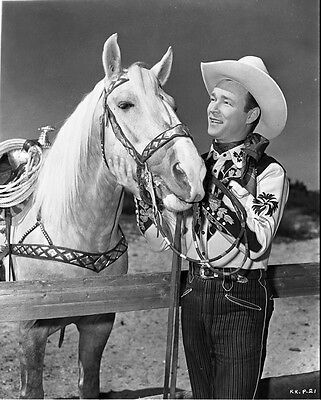A Horse Is a Horse (Of Course Of Course)
Tom Mix and Tony
I gotta admit that movie Westerns are still one of my guilty pleasures. As a kid I was fan of both Roy Rogers and the Lone Ranger, delivered newspapers to both Milburn Stone (old “Doc Adams” of Gunsmoke fame) and perennial bad guy Jack Elam, was mesmerized by our down-the-street neighbor John Anderson (who played Abraham Lincoln on at least three occasions), and was family friends with Bill Williams (Kit Carson), his wife Barbara Hale (Della Street) and son William Katt (The Greatest American Hero). As kids, we spent quite a bit of time hanging out at “Corriganville,” a wonderful Western town in nearby Simi Valley where dozens upon dozens of Cowboy movies were filmed in the 40s and 50s, and the Iverson Movie Ranch (situated in the Santa Susana Pass just above Chatsworth, where everyone from Buster Keaton and Hopalong Cassidy to Roy Rogers, the Lone Ranger and John Wayne shot movies. (Particularly well-known is a section of the Iverson Ranch known as the “Garden of the Gods"“; even though you’ve likely never heard of it, you’ve seen it a million times . . . everyone shot Westerns there.
Ever since the first cowboy star, “Broncho Billy” Anderson (Max Aronson) rode onto the silver screen in 1903, their horses played an integral role; they became teams to such an extent that saying “Tom Mix” without adding . . . and Tony” was as unthinkable as uttering the name “Romeo” and forgetting to add “. . . and Juliette.”) Of all the horses of my childhood, none could hold a candle to Roy Rogers’ magnificent Palomino, “Trigger.” Hollywood Brats of the post-War era will well remember “Uncle Ben’s Kiddie Park,” way out Van Nuys Blvd. in the Panorama City section of the San Fernando Valley. “Uncle Ben” had a pretty good collection of tame equines of all colors and sizes. Everyone’s favorite was, of course, a magnificent Palomino who could easily have passed for “Trigger’s” twin. We were so young and naive that we didn’t even know if this “Trigger” was a girl or a boy; we never thought to check under or behind its tail. We would wait in line for up to two hours just for the chance to spend ten or fifteen minutes riding this wondrous creature . . . wearing our Roy Rogers hat and spurs and imagining Dale Evans and “Buttermilk” riding alongside. Ah, those were the days. We were so young, so innocent and naive; we had no idea that kids around the world didn’t live in such proximity to our heroes.
As already mentioned, the horses these cinematic cowboys rode became stars in their own right. Despite the fact that at first, the Arkansas-born Broncho Billy didn’t know whether to mount a horse from the right or left, (it’s the left), “Ranger” became his costar in more than 350 one- and two-reel films. As time progressed, the horses became more and more famous: For more than twenty-five years, the most famous horses in Hollywood were Tom Mix’s “Tony” (pictured above), William S. Hart’s “Fritz,” (shown below on left) Hoot Gibson’s variously named “Goldie,” “Midnight,” “Starlight,” “Mutt,” and “Pal” (not to mention “Silver”); Ken Maynard’s “Tarzan,” Richard Dix’s “Dice,” Hopalong Cassidy’s “Topper,” Gene Autry’s “Champion” and Audie Murphy’s “Rebel”. Without question “Silver” was the most popular of all equine names. For in addition to the Lone Ranger (Clayton Moore’s horse), Sunset Carson, Whip Wilson, and the aforementioned Hoot Gibson all had horses bearing the same name.
In some cases, the actors actually owned the horses they rode on screen. Most notable were Roy Rogers and Trigger, Dale Evans and “Buttermilk.” and John Wayne and “Dollar.” But John Wayne did not have the financial wherewithal to purchase or care for a horse until later on in his career. And here hangs a tale . . .
John Wayne (Marion Michael Morrison) and his football team buddy Ward Bond played for the University of Southern California in the late 1920s. They were spotted by director John Ford who liked them, and hired the two to move furniture from one scene to another. Eventually, Ford started using the pair as extras in crowd scenes. After appearing in 20 unaccredited bits at various studios between 1926 and 1930, Morrison (by now renamed “John Wayne”) was hired for the lead in Howard Hawks’ 1930 film ”The Big Trail,” which was an absolute bomb. Ford, who was furious with Wayne, let his protege suffer through more than 60 third—rate roles for minor-league producers until, to Ford’s way of thinking, Wayne was ready for stardom. That would not come until 1939, when Ford cast Wayne as “The Ringo Kid,” in Stagecoach, which would make eventually make Wayne a star. During his cinematic apprenticeship, Wayne appeared in dozens of westerns, some even “starring” him as a character called “Singing Sandy.” At the time of his cinematic apprenticeship, he rode a horse called “Duke.” Eventually, when he became a star, his nickname would also be “Duke.” Within the Hollywood community, this nickname was a bit of a insult. In referring to him as “Duke” Wayne, it was a way of proclaiming that he was no more an actor than his horse. To this day, it is likely that few understand its genesis.
It helps to be a “Hollywood Brat.”
Copyright©2019 Kurt F. Stone



